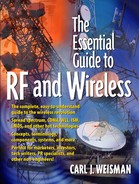Appendix B. Specifications
This appendix is intended for people working in the RF industry who need to understand the arcane language of component performance. Contained herein are the most common electrical performance characteristics of RF components. Each parameter is broken down by its specification name, its most common symbol or acronym, the unit of measure, and where it is most often used.
| Specification | Symbol or Acronym | Unit of measure | Typically measures |
|---|---|---|---|
| Amplitude unbalance | dB | The difference in insertion loss on two paths of a power divider. | |
| Attenuation | dB | The amount of signal loss in an attenuator or other passive component. | |
| Bandwidth | BW | MHz, GHz | The useful frequency range of a component. |
| Compression point (output) | P1dB | dBm | The linear power output capability of a component. |
| Compression point (input) | dBm | The linear power input capability of a component. | |
| Conversion gain | dB | The signal gain in an active mixer. | |
| Conversion loss | CL | dB | The insertion loss in a passive mixer. |
| Coupling | dB | The amount of the signal which is "siphoned off" in a directional coupler. | |
| Directivity | dB | The ability of a directional coupler to direct RF energy onto the desired port. | |
| Gain | G | dB | The amount a signal increases as it passes through an amplifier. |
| Gain flatness | ΔG | dB | How much the gain of an amplifier varies over its bandwidth. |
| Harmonics (suppression) | dBc | The amount of unwanted signals, in a particular bandwidth, which are a frequency multiple of the desired signal. | |
| Image rejection | dB | The amount of attenuation of the unwanted signal coming out of a mixer. | |
| Impedance | Ω | ohms | The resistance a signal experiences when entering a component. |
| Impedance ratio | N:1 | The impedance changing ability of a transformer. | |
| Insertion loss | IL | dB | The loss a signal experiences as it travels through a passive component. |
| Intermodulation distortion | IMD | dBc | The amount of unwanted signals as a result of mixing two signals. |
| Isolation | ISOL | dB | The insertion loss in the open path of a switch or between two ports on a passive device. |
| Match | VSWR | How well a signal is transferred from one component to another. | |
| Noise figure | NF | dB | The input sensitivity of a low noise amplifier. |
| Noise temperature | °K | The input sensitivity of very low noise figure LNAs. | |
| Phase noise | dBc/Hz | Signal distortion resulting from unintended phase modulation. | |
| Phase shift | δφ | degrees | The angular shift in an RF signal as it travels through a component. |
| Phase unbalance | degrees | The difference in phase shift on two paths of a power divider. | |
| Power added efficiency | PAE | % | The efficiency with which a power amplifier turns DC power into RF power. |
| Pulling factor | MHz | The change in the output frequency of an oscillator when the input impedance of the device it is driving changes. | |
| Return loss | RL | dB | The amount of the signal which is reflected at the interface of two components. |
| Reverse isolation | S12 | dB | The isolation from the output to the input of a component. |
| Saturated power | Psat | dBm | The maximum amount of power an amplifier can put out. |
| Second order intercept | Ip2 | dBm | The linearity of a component. |
| Selectivity | Q | The efficiency of a filter in tuning out unwanted frequencies. | |
| Settling time | msec | The time it takes for a VCO's output to stabilize after a frequency change. | |
| Spurious noise (spurs) | dBc | Random noise in an RF signal. | |
| Stability | ppm | The change in output frequency of an oscillator over time. | |
| Switching time | tsw | msec, nsec | The time for a switch to change positions. |
| Thermal impedance | θjc | °C/W | The rise in temperature of a component which is dissipating power. |
| Third order intercept (output) | Ip3, OIP | dBm | The linearity of a component's output signal. |
| Third order intercept (input) | IIP | dBm | The linearity of a component's input signal. |
| Tuning sensitivity | MHz/V | The change in the output frequency of a VCO with a change in the control voltage. |
..................Content has been hidden....................
You can't read the all page of ebook, please click here login for view all page.
